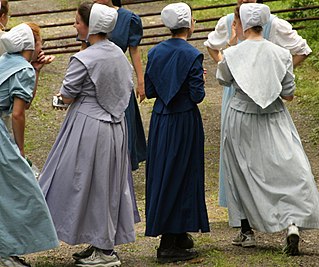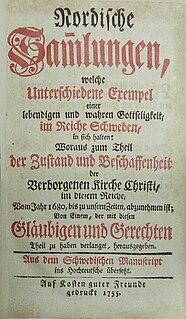Related Research Articles

Anabaptism is a Christian movement which traces its origins to the Radical Reformation. The movement is commonly understood to be an offshoot of Protestantism, though this view is not shared by Anabaptists, who view themselves as a separate branch of Christianity.

The Mennonites are members of certain Christian groups belonging to the church communities of Anabaptist denominations named after Menno Simons (1496–1561) of Friesland. Through his writings, Simons articulated and formalized the teachings of earlier Swiss founders, with the early teachings of the Mennonites founded on the belief in both the mission and ministry of Jesus, which the original Anabaptist followers held with great conviction, despite persecution by various Roman Catholic and Protestant states. An early set of Mennonite beliefs was codified in the Dordrecht Confession of Faith in 1632, but the various groups do not hold to a common confession or creed.

The Brethren in Christ Church (BIC) is an River Brethren Christian denomination with roots in the Mennonite church, Radical Pietism, and Wesleyan holiness. They have also been known as River Brethren and River Mennonites.
The Missionary Church is an evangelical Christian denomination of Anabaptist origins with Wesleyan and Pietist influences.

The Old Order River Brethren are a small Old Order River Brethren denomination of Christianity with roots in the Mennonite Church and the Radical Pietist movement of the Schwarzenau Brethren.
The United Zion Church is a River Brethren Christian denomination with roots in the Mennonite Church and the Radical Pietistic movement.
The Church of the United Brethren in Christ is an evangelical Christian denomination with churches in 17 countries. It is Protestant, with an episcopal structure and Arminian theology, with roots in the Mennonite and German Reformed communities of 18th-century Pennsylvania, as well as close ties to Methodism. It was organized in 1800 by Martin Boehm and Philip William Otterbein and is the first American denomination that was not transplanted from Europe. It emerged from United Brethren churches that were at first unorganized, and not all of which joined this church when it was formally organized in 1800, following a 1789 conference at the Otterbein Church.

The River Brethren are a group of historically related Anabaptist Christian denominations denominations originating in 1770, during the Radical Pietist movement among German colonists in Pennsylvania. In the 17th century, Mennonite refugees from Switzerland had settled their homes near the Susquehanna River in the northeastern United States.
The US Conference of Mennonite Brethren Churches (USMB) is an association of Mennonite Brethren Churches in the United States.

The Canadian Conference of Mennonite Brethren Churches (CCMBC) is the conference of Mennonite Brethren in Canada. It is a member of the Mennonite World Conference and the Evangelical Fellowship of Canada.

The Mennonite Brethren Church was established among Plautdietsch-speaking Russian Mennonites in 1860, and has congregations in more than 20 countries, representing about 500,000 adherents as of 2019.

Mennonite Central Committee (MCC) is a relief, service, and peace agency representing fifteen Mennonite, Brethren in Christ and Amish bodies in North America. The U.S. headquarters are in Akron, Pennsylvania, the Canadian in Winnipeg, Manitoba.

Peace churches are Christian churches, groups or communities advocating Christian pacifism or Biblical nonresistance. The term historic peace churches refers specifically only to three church groups among pacifist churches:

Martin Boehm was an American clergyman and pastor. He was the son of Jacob Boehm and Barbara Kendig who settled in Lancaster, Pennsylvania. Boehm married Eve Steiner in 1753 and in 1756 he was chosen by lot to become the minister of the local German-speaking Mennonite church.
Samuel Hiestand was an American Bishop of the Church of the United Brethren in Christ, elected in 1833. He was the ninth Bishop of this Christian denomination.

Radical Pietism are Pietists who decided to break with denominational Lutheranism, forming separate Christian churches. Radical Pietists contrast with Church Pietists, who chose to remain within their Lutheran denominational settings. Radical Pietists distinguished between true and false Christianity. They separated from established churches to form their own sects.
The Swankites were an offshoot of the Wengerites formed in Ohio in 1861. This occurred over issues of meeting length, church order and method of baptism. They called themselves the Brethren in Christ, a name used by both the Wengerites and the River Brethren at that point.
Brethren is a name adopted by a wide range of mainly Christian religious groups throughout history. The largest movements by this name are the Schwarzenau Brethren, Anabaptists, Moravian Brethren, and Plymouth Brethren.
The Old Order Movement is a religious movement to preserve the old ways of Anabaptist religion and lifestyle. Historically, it emerged in the second half of the 19th century among the Amish, Mennonites of South German and Swiss ancestry as well as the Schwarzenau Brethren in the United States and Canada. The movement led to several Old Order divisions from mainstream Anabaptist groups between 1845 and 1901. All Old Order groups that emerged after 1901 divided from established Old Order groups or were formed by people coming from different Old Order groups. The highly conservative Old Colony Mennonites and the Hutterites were not directly connected to this movement.
References
- ↑ Hostetter, C. Nelson and E. Morris Sider (1990). "Brethren in Christ Church". Global Anabaptist Mennonite Encyclopedia Online. Retrieved 20 July 2009.